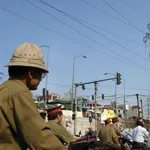
Vietnam and the mekong mix
In 1986, Vietnam's Sixth Party Congress initiated the country's first broad economic reform package that introduced guidelines for expansion, laying a vitally needed foundation for a vastly improved investment climate.
For the next eleven years things improved dramatically, with investment pouring in until the "Great Melt-Down of 1997" which caused a re-think in Hanoi as the GDP growth dropped from a steamy 8 - 9% to a still respectable 6% from 1997 to 2004.
The economic landslide of 1997 was for more painful in the region's more advanced economies. Vietnam had a lower height to fall from and had still retained its "flavour of the month" attraction through ASEAN is recovery period.
Throughout this dicey half decade the Vietnam leadership continued their commitment to economic liberalization and international integration.
In 2001 they joined ASEAN and AFTA. That year (in December) they signed off on the U.S. - Vietnam Bilateral Trade Agreement resulting in an astonishing 900% rise in exports to the U.S. from 2001 to 2007 and making the U.S.A. their most important trading partner by the year (2007) they joined the WTO.
Today, the country is moving forward at a healthy 7.8% per annum with a poverty reduction trackrecord better than China, India and the Philippines (based on the "Deep Poverty" definition of the percentage of population living under one US$ dollar per day).
12 million land lines and 36 million mobile phones are in use, connecting 86 million people.
Ford's "Haiduong" assembly plant's production of their Mondeo, Focus, Everest, Escape SUV's and Ranger Pickups is doing for Ford in Vietnam what the ubiquitous "Buick" lines does for General Motors in China.
Hanoi
Compared to China's "secondary" cities, Hanoi is a village. A national capital that excludes its distinct personality (think-Ottowa, Canberra, etc.)
Some Comparisons:
Population figures for Hanoi range from 3.2 million upwards yet the "feel" of the city is that of well under a million due to the dispersion of citizenry across a broad area.Very little "high-Rise". The average person in Hanoi lives between the 1st and 2nd floors while the average person in Hong Kong lives between the 15th and 16th floors.
Vietnam's population of 86 million staggers into their emerging prosperity using every possible KW of it's 11,600 MW of installed capacity.
Hong Kong's economically mature population of 7.7 million enjoys an installed capacity of 12,000 MW plus a substantial reserve of "redundant" power that exists due to the peculiarities of the "Scheme of Control" agreement (this surplus is sent into the power starved PRD ).
The Big Conference
On June 19th and 20th, INC Global (Singapore) ran a highly successful "Vietnam Energy and Power 2008" conference in Hanoi at the same venue as our Retreat (see below).
I was privileged to be their Day One Chair. Subjects and speakers included:
• Global fuel pricing / availability with implications for the Vietnam power sector by Wayne Mikutowicz, Vice President - Nexant Inc. (Bangkok).
• A fabulous recap on strategies and plans by ADB in support of projects in the greater Mekong by Mr. Yong Ping Zhai, Principal Energy Specialist - ADB (Manila). This was an eye opener in that the Mekong marketplace includes Yunnan Province in China in the North, Myanmar in the West, and South through Vietnam, Laos, Thailand and Cambodia.
These six countries are developing baskets of bilateral power trade agreements with umbrella support from ADB, IFC and World Bank that regions in Europe, South America and Africa could learn from.
• An update on the energy business model in Vietnam covering regulatory frameworks by Mr. Ngo Quang Thuy and Mr. Hoany Minch Duc of "Duane Morris" (Hanoi) who did a nice double act on how to package the deal.
• Mr. Sharad Somani of KPMG (Singapore) gave a very authoritative presentation entitled "Equitization in Power Sector" with insights on key challenges and investor expectations Somani is a director / member of KPMG's Global Infrastructure and Project Group, KPMG.
His list of 18 power production portfolios calling for investment via the "Ministry of Industry" contained projects ranging from 41MW to 3,000 MW, totaling 11566MW.
If all of these are commissioned within the next five to seven years it would be a doubling of Vietnam's installed power (currently 11,600MW).
• From GE we had Messers James Kim (Asia Region Manager Energy Services and Eric Lee (Facility Manager, K-Power LNG) expanding on plant operations, Mr. Lee actually runs the 1000 MW K-Power plant which is 65% owned by the "SK Corp" and 35% by BP Power in Korea.
• Mr. Prutichai Chonglertranichkul, Assistant Governor - Planning, EGAT, presented on the "Thailand Power Development Plan and Project updates".
His comments included power exchange relationships between China, Myanmar, Laos and Cambodia, mainly into Thailand.
Augmenting Thailand's current installed capacity (as of May 31st, 2008) of 29,964 MW are MOU's on power imports of 7,000 MW from Laos, 1,500 MW from Myanmar and 3,000 MW from China.
This imported 11,5000 MW(please check with Joel Laykin) won't be on line for a couple of years.
In the meantime, EGAT is projecting an internal power production increase of approximately 2,000MW per annum pushing domestic production up to just below 60,000MW by 2021.The INC Global conference closed on the 20th (Friday) with a lunch.
IPPF speakers / attendees: Colin Tam - AEI, Byron Wong - Chevron, Dominic Yin and Hazel Shao - EESCO/P2E2, Dave Maslin - Worley Parsons and Joel Laykin - IPPF / Laykin Communications stayed on for the IPPF following Retreat which kicked off with an arrival cocktails reception on the same Friday evening.



















 Advertise
Advertise







